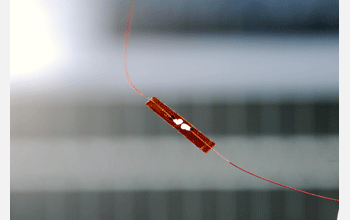Multimedia Gallery
Flexible Charge Pump (Image 2)
A flexible charge pump generates alternating current as it is stretched and then relaxed. (Date of Image: October 2008) [See related image Here.]
More about this Image
The new "flexible charge pump" generator, developed by Zhong Lin Wang, Regent's Professor in the School of Materials Science and Engineering and Director of the Center for Nanostructure Characterization at the Georgia Institute of Technology, is the fourth generation of devices designed to produce electrical current by using the piezoelectric properties of zinc oxide structures to harvest mechanical energy from the environment. Its development was reported Nov. 9, 2008, in the advance online publication of the journal Nature Nanotechnology.
"The flexible charge pump offers yet another option for converting mechanical energy into electrical energy," said Wang. "This adds to our family of very small-scale generators able to power devices used in medical sensing, environmental monitoring, defense technology and personal electronics."
The new generator can produce an oscillating output voltage of up to 45 millivolts, converting nearly seven percent of the mechanical energy applied directly to the zinc oxide wires into electricity. For the future, Wang sees the family of small-scale generators enabling development of a new class self-powered wireless sensing systems. The devices could gather information, store it and transmit the data--all without an external power source. The research has been supported by the U.S. Department of Energy, the National Science Foundation, the Air Force Office of Scientific Research and the Emory-Georgia Tech Center for Cancer Nanotechnology Excellence. To learn more about this research, see the Georgia Tech news release, Flexible Charge Pump: New Small-Scale Generator Produces Alternating Current by Stretching Zinc Oxide Wires.
Credit: Georgia Tech photo by Gary Meek
Images and other media in the National Science Foundation Multimedia Gallery are available for use in print and electronic material by NSF employees, members of the media, university staff, teachers and the general public. All media in the gallery are intended for personal, educational and nonprofit/non-commercial use only.
Images credited to the National Science Foundation, a federal agency, are in the public domain. The images were created by employees of the United States Government as part of their official duties or prepared by contractors as "works for hire" for NSF. You may freely use NSF-credited images and, at your discretion, credit NSF with a "Courtesy: National Science Foundation" notation.
Additional information about general usage can be found in Conditions.
Also Available:
Download the high-resolution JPG version of the image. (2.7 MB)
Use your mouse to right-click (Mac users may need to Ctrl-click) the link above and choose the option that will save the file or target to your computer.

